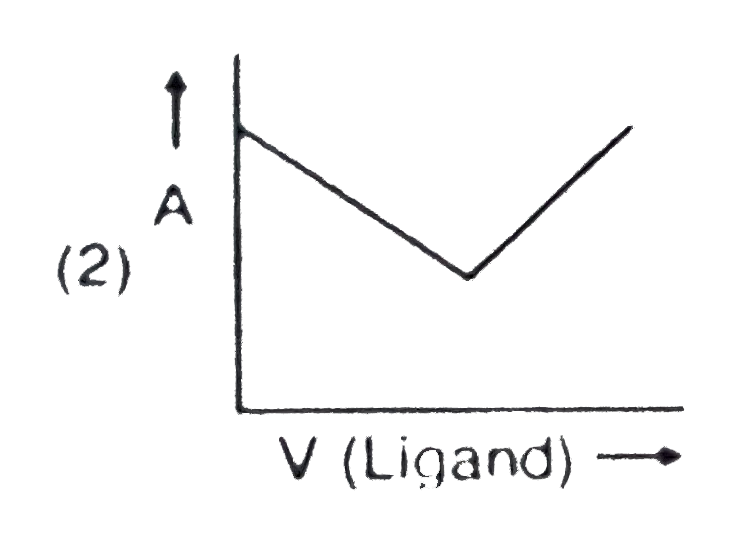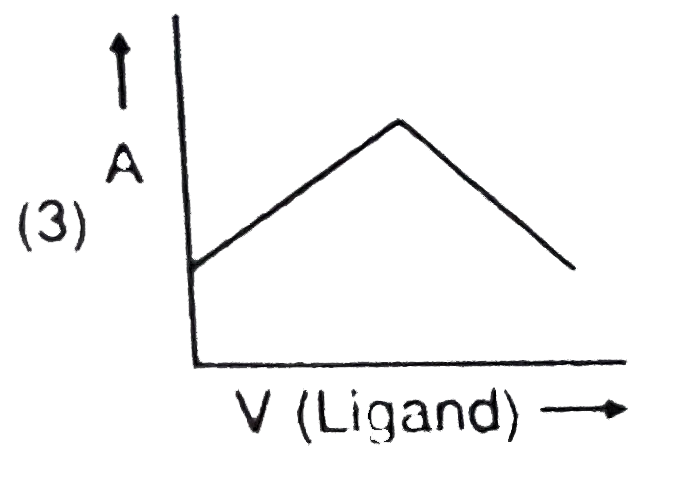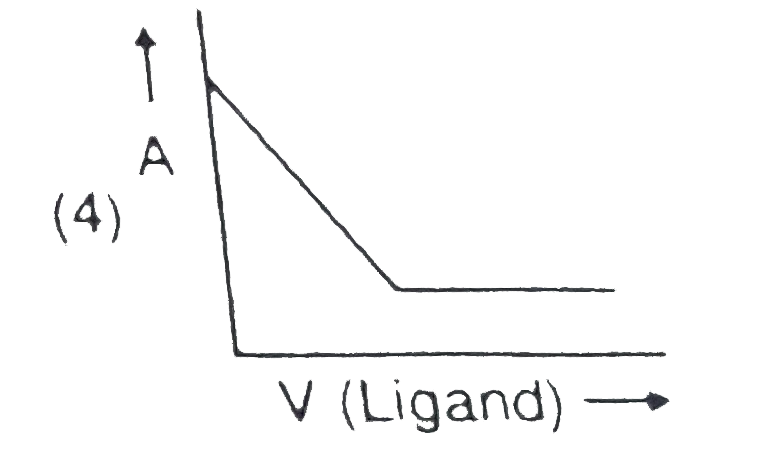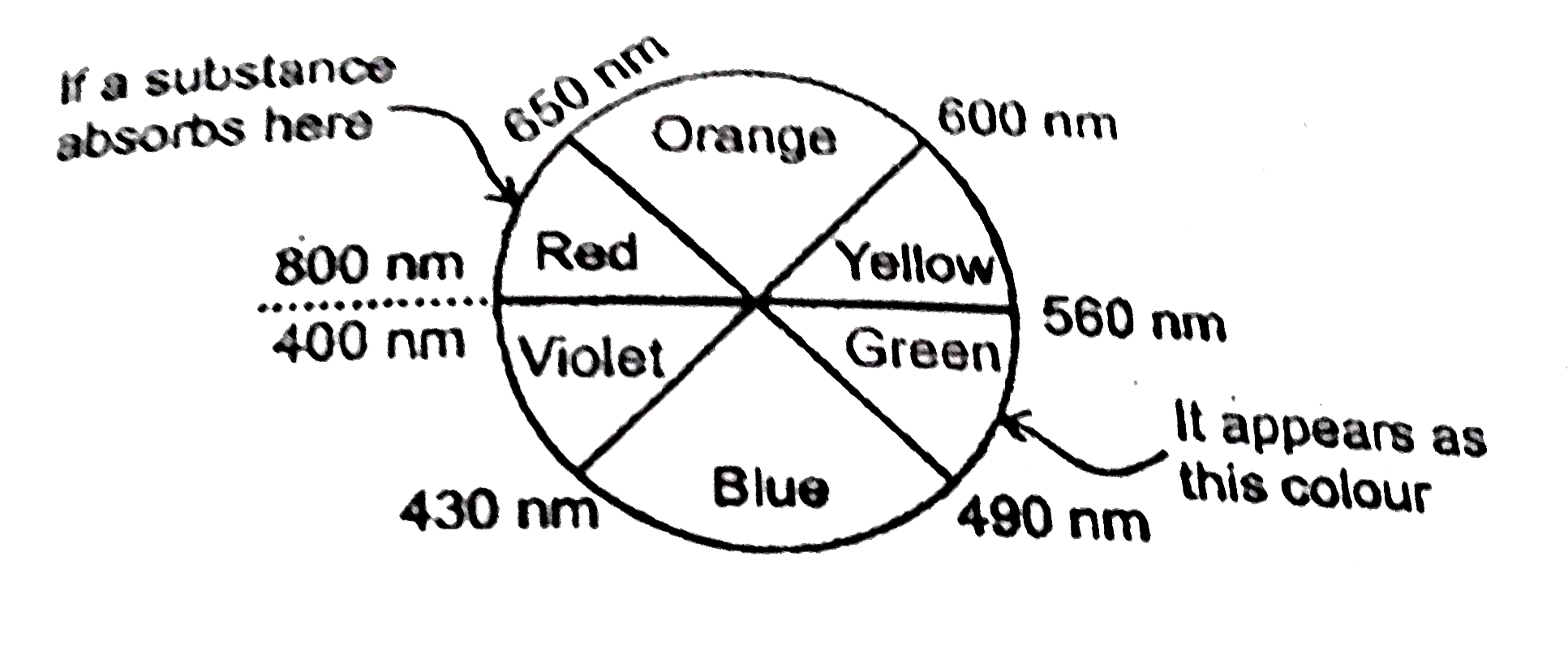In a complexometric titration of metal ion with ligand
M(Metal ion)+L(Ligand)→C(Complex) end point is estimated spectrophotometrically (through light absorption). If 'M' and 'C' do not absorb light and only 'L' absorbs, then the titration plot between absorbed light(A) versus volume of ligand 'L' (V) would look like :




The correct Answer is:A
Step by step video, text & image solution for In a complexometric titration of metal ion with ligand M("Metal ion") + L("Ligand")rarr C("Complex") end point is estimated spectrophotometrically (through light absorption). If 'M' and 'C' do not absorb light and only 'L' absorbs, then the titration plot between absorbed light(A) versus volume of ligand 'L' (V) would look like : by Chemistry experts to help you in doubts & scoring excellent marks in Class 12 exams.
Topper's Solved these Questions
- BOOK - RESONANCECHAPTER - COORDINATION COMPOUNDSEXERCISE - Additional Problem for Self Practice (APSP) Part-I30videos
COORDINATION COMPOUNDS
- BOOK - RESONANCECHAPTER - COORDINATION COMPOUNDSEXERCISE - Additional Problem for Self Practice (APSP) Part-II68videos
COORDINATION COMPOUNDS
- BOOK - RESONANCECHAPTER - COORDINATION COMPOUNDSEXERCISE - Exercise-3 Part-II: JEE(Main ) /AIEEE Problem36videos
COORDINATION COMPOUNDS
- BOOK - RESONANCECHAPTER - CHEMISTRY IN EVERYDAY LIFEEXERCISE - ORGANIC CHEMISTRY(Chemistry in every day life)31videos
CHEMISTRY IN EVERYDAY LIFE
- BOOK - RESONANCECHAPTER - D & F BLOCK ELEMENTSEXERCISE - INORGANIC CHEMISTRY(d & f- Block Elments)40videos
D & F BLOCK ELEMENTS
Similar Questions
Homoleptic octahedral complexes of a metal ion 'M3+' with three monodentate ligands L1,L2 and L3 absorb wavelengths in the region of green, blue and red respectively. The increasing order of the ligand strength is :
View SolutionRead the passage given below and answer the following questions :
The crystal field theory (CFT) is an electrostatic model which considers the metal-ligand bond to be ionic arising purely from electrostatic interactions between the metal ion and the ligand. Ligands are treated as point charges in case of anions or dipoles in case of neutral molecules. The five d orbitals in an isolated gaseous metal atom/ion have same energy, i.e., they are degenerate. This degeneracy is maintained if a spherically symmetrical field of negative charges surrounds the metal atom/ ion. However, when this negative field is due to ligands (either anions or the negative ends of dipolar molecules like NH3 and H2O) in a complex, it becomes asymmetrical and the degeneracy of the d orbitals is lifted. It results in splitting of the d orbitals.
An aqueous pink solution of cobalt(II) chloride changes to deep blue on addition of excess of HCl. This is because _________.View Solution
Knowledge Check
- Question 1 - Select One
The octahedral complex of a metal ion M3+ with four monodentate ligands L1,L2,L3 and L4 absorb wavelengths in the region of red,green, yellow and bule, respectively The increasing order of ligand strengh of the four ligands is
AL1<L2<L4<L3BL4<L3<L2<L1CL1<L3<L2<L4DL3<L2<L4<L1 - Question 2 - Select One
A. According to C.FT complex compound contain point charges
R: The bonding between central metal ion and ligand is electrostaticAIf both Assertion & Reason are true and the reason is the correct explanation of the assertion, then mark (1)BIf both Assertion & Reason are true but the reason is not the correct explanation of the assertion, then mark (2).C) If Assertion is true statement but Reason is false, then mark (3).DIf both Assertion and Reason are false statements, then mark (4) - Question 3 - Select One
Read the passage given below and answer the following questions :
The crystal field theory (CFT) is an electrostatic model which considers the metal-ligand bond to be ionic arising purely from electrostatic interactions between the metal ion and the ligand. Ligands are treated as point charges in case of anions or dipoles in case of neutral molecules. The five d orbitals in an isolated gaseous metal atom/ion have same energy, i.e., they are degenerate. This degeneracy is maintained if a spherically symmetrical field of negative charges surrounds the metal atom/ ion. However, when this negative field is due to ligands (either anions or the negative ends of dipolar molecules like NH3 and H2O) in a complex, it becomes asymmetrical and the degeneracy of the d orbitals is lifted. It results in splitting of the d orbitals.
A chelating agent has two or more than two donor atoms to bind to a single metal ion. Which of the following is not a chelating agent ?AthiosulphatoBoxalatoCglycinatoDethane-1,2-diamine
Read the passage given below and answer the following questions :
The crystal field theory (CFT) is an electrostatic model which considers the metal-ligand bond to be ionic arising purely from electrostatic interactions between the metal ion and the ligand. Ligands are treated as point charges in case of anions or dipoles in case of neutral molecules. The five d orbitals in an isolated gaseous metal atom/ion have same energy, i.e., they are degenerate. This degeneracy is maintained if a spherically symmetrical field of negative charges surrounds the metal atom/ ion. However, when this negative field is due to ligands (either anions or the negative ends of dipolar molecules like NH3 and H2O) in a complex, it becomes asymmetrical and the degeneracy of the d orbitals is lifted. It results in splitting of the d orbitals.
The CFSE for octahedral [CoCl6]4− is 18,000cm−1. The CFSE for tetrahedral [CoCl4]2− will beView SolutionCrystal field theory views the bonding in complexes as arising from electrostatic interaction and considers the effect of the ligand charges on the energies of the metal ion d-orbitals
In this theory, a ligand lone pair is modelled as a point negative charge that repels electrons in the d-orbitals of the central metal ion.The theory concentrated on the resulting splitting of the d-orbitals in two groups with different energies and used that splitting to rationalize and correlate the optical spectra,thermodynamic stability, and magnetic properties of complexes.This energy splitting between the two sets of d-orbitals is called the crystal field splitting Δ.
In general, the crystal field splitting energy Δ corresponds to wavelenght of light in visible region of the spectrum, and colours of the complexes can therefore be attributed to electronic transition between the lower and higher energy sets of d-orbitals.
In general, the colour that we see is complementry to the colour absorbed.

Different metal ions have different value of Δ, which explains why their complexes with the same ligand have different colour.
Similarly the crystal field splitting also depends on the nature of ligands and as the ligand for the same metal varies from H2O to NH3 to ethylenediamine, Δ for complexes increase.Accordingly, the electronic transition shifts to higher energy (shorter wavelength) as the ligand varies from H2O from NH3 to en, thus accounting for the variation in colour.
Crystal field theory accounts for the magnetic properties of complexes in terms of the relative values of Δ and the spin pairing energy P. Small Δ values favour high spin complexes, and large Δ values favour low spin complexes.
The [Ti(NCS)6]3− ion exhibits a single absorption band at 544 nm.What will be the crystal field splitting energy (in kJ mol−1) of the complex ? (h=6.626×10−34J.s,C=3.0×105m/s,NA=6.02×1023 ions/mole.View SolutionValence bond theory for bonding in transition metal complexes was developed by Pauling. From the valence bond point of view, formation of a complex involves reaction between Lewis bases (ligands) and a Lewis acid (metal atom or metal ion) with the formation of coordination covalent (or dative) bonds between them. The model utilizes hybridization of metal s, p and d valence orbitals to account for the observed structures and magnetic properies of complexes.
Valence bond theory is able to deal satisfactorily with many stereo chemical and magnetic properies but is has nothing to say about electronic spectra or the reason for the kinetic inertness of chromium (III) and low spin cobalt (III) octahedral complexes. To understand this and more other features of transition metal we must turn to other theories like crystal field theory etc.
Pure crystal field theory assumes that the only interaction between the metal ion and the ligands is an electrostatic or ionic one with the ligands being regarded as negative point charges. This theory is quite successful in interpreting many important properties of complexes.
The hybridization of [NiCl2(PPh3)2] and [NiCl2.(Pme3)2] are respectively (consider PPh3 a bulkier ligand than Pme3) :View SolutionValence bond theory for bonding in transition metal complexes was developed by Pauling. From the valence bond point of view, formation of a complex involves reaction between Lewis bases (ligands) and a Lewis acid (metal atom or metal ion) with the formation of coordination covalent (or dative) bonds between them. The model utilizes hybridization of metal s, p and d valence orbitals to account for the observed structures and magnetic properies of complexes.
Valence bond theory is able to deal satisfactorily with many stereo chemical and magnetic properies but is has nothing to say about electronic spectra or the reason for the kinetic inertness of chromium (III) and low spin cobalt (III) octahedral complexes. To understand this and more other features of transition metal we must turn to other theories like crystal field theory etc.
Pure crystal field theory assumes that the only interaction between the metal ion and the ligands is an electrostatic or ionic one with the ligands being regarded as negative point charges. This theory is quite successful in interpreting many important properties of complexes.
The hybridization of [NiCl2(PPh3)2] and [NiCl2.(Pme3)2] are respectively (consider PPh3 a bulkier ligand than Pme3) :View SolutionValence bond theory for bonding in transition metal complexes was developed by Pauling. From the valence bond point of view, formation of a complex involves reaction between Lewis bases (ligands) and a Lewis acid (metal atom or metal ion) with the formation of coordination covalent (or dative) bonds between them. The model utilizes hybridization of metal s, p and d valence orbitals to account for the observed structures and magnetic properies of complexes.
Valence bond theory is able to deal satisfactorily with many stereo chemical and magnetic properies but is has nothing to say about electronic spectra or the reason for the kinetic inertness of chromium (III) and low spin cobalt (III) octahedral complexes. To understand this and more other features of transition metal we must turn to other theories like crystal field theory etc.
Pure crystal field theory assumes that the only interaction between the metal ion and the ligands is an electrostatic or ionic one with the ligands being regarded as negative point charges. This theory is quite successful in interpreting many important properties of complexes.
Which of the following is correct for the complex [Ti(H2O)6]3+ ?View Solution

